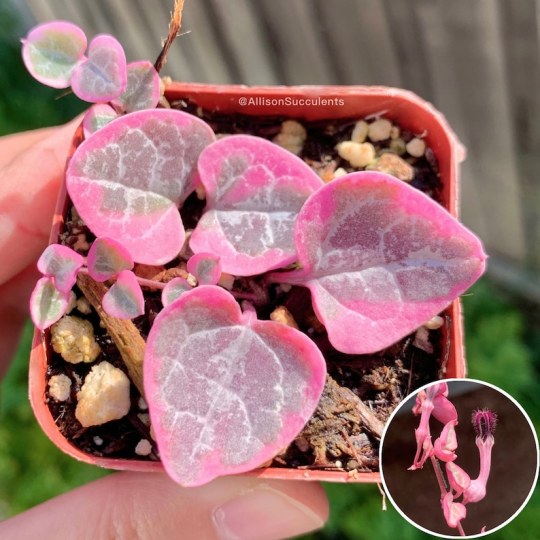#AllisonSucculents
Photo

String of Hearts Variegated // AllisonSucculents
87 notes
·
View notes
Text
Variegated String of Hearts
I just received my Variegated String of Hearts! Very excited to add this one to my collection! While it wasn't the first plant I physically obtained, it was the first one I ordered to start out my collection, and after a few weeks of waiting it's arrived safely!
· · ──────────── ·𖥸· ──────────── · ·


My plant and photo, Purchased from: AllisonSucculents on Etsy!
· · ──────────── ·𖥸· ──────────── · ·
➸ Basic Info
The String of Heart (Ceropegia woodii) is a trailing succulent native to South Africa, Swaziland, and Zimbabwe that can grow strings over 9 feet long! It gets its name from its heart shaped leaves, and can come in a variety of colors including green, pink, purple, silver, and creamy white.
· · ──────────── ·𖥸· ──────────── · ·
➸ Care
• Temperature
Unless you live somewhere that maintains a constant temperature of over 60°, the string of hearts is a plant best kept potted. They prefer to be kept at a temperature range of 80°-85° (or 60° During the Winter Time)
• Light
The sting of hearts loves light, but not direct sunlight! It'll be the happiest when placed next to a large window- I personally will be keeping mine on a screened in porch! Remember that too much light can scotch a succulent, and too little will cause it to discolor or become over watered more easily. Rotating your succulent will also help ensure the entire plant is getting the proper amount of exposure to light. One way to tell that your sting of hearts isn't getting enough light is the leaves will begin to grow wider apart and become less marbled, and paler in color
• Watering
The very first tip I was given by a fellow plant owning friend when I asked her for tips, was to water your string of hearts from the bottom! Submerge around 1/4 of your plant for roughly 10 minutes, then allow it to drain thoroughly to prevent root rot. It's recommended to water it once weekly during the spring and summer, or when the top few inches of soil are dry. During the Fall and winter, your plant will be dormant and only need water once a month or when the soil goes entirely dry. One good way to tell when your plant needs water is when the leaves are softer and squishy. A healthy string of hearts will have tight, turgid leaves. If your plants leaves grow yellow, brown, or black and are mushy, you're most likely over watering.
• Humidity
String of Hearts do best when kept at a humidity level of 40-60%. Your plant may begin to shrivel and turn brown while not growing much if the humidity is too low. Too much humidity may encourage fungal growth or pest breeding, as well as root rot. Yellow, suddenly dropping leaves are a good sign your plant may be too humid!
• Repotting
String of Hearts like to be reported every few years, or when the roots begin to grow out of the drainage holes of its pot. They also do best being repotted during the summer, but take extra care handling these plants as their leaves can be very delicate. This is also a good opportunity to add new, more nutrient-rich soil to make sure the plant is getting everything it needs.
· · ──────────── ·𖥸· ──────────── · ·
✔️ This plant is pet safe
· · ──────────── ·𖥸· ──────────── · ·
Articles Referenced, as well as good resources for sting of heart owners:
Succulentsbox.com
Greg.app
Thespruce.com
#string of hearts#variegated string of hearts#variegated#horticulture#gardening#house plants#botany#pink house plants#pink plants#plantblr#plants#floral#flowers#ftm#transgender#t4t#houseplants#houseplant
5 notes
·
View notes
Photo

My pink succulents🥰 by AllisonSucculents
27 notes
·
View notes